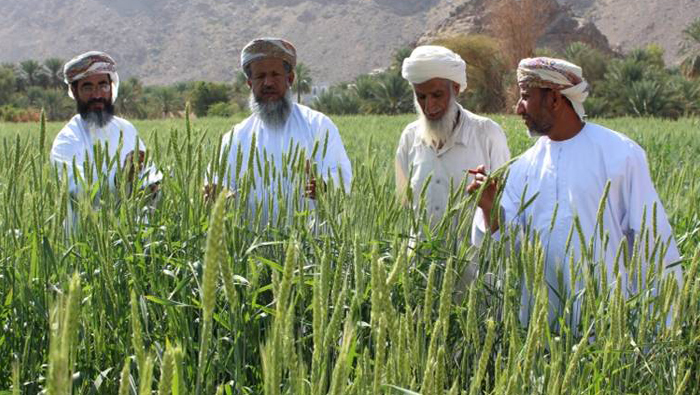
Bahla: Wheat is one of the most important grain crops grown in the Sultanate.
It has become an agricultural heritage for the Omani farmer. It was cultivated in large areas in various regions of the Sultanate. According to statistics of the Ministry of Agriculture and Fisheries, wheat cultivation in the Sultanate fluctuates from one season to another depending on the abundance of water.
The statistics indicate that the cultivated area of wheat in the Sultanate in 1980 stood at more than 3,000 acres, with a production rate of about 600 kg/acre. This area has gradually decreased to reach 2,103 acres, according to the statistics of 2017, with a productivity rate of 1,010 kg per acre.
The decline in the area cultivated with wheat is attributed to the introduction of new crops of vegetables and fruits with a rapid and cost-effective return to farmers, as well as the availability of imported wheat alternatives and the availability of flour in the market at relatively cheap prices.
Although the area cultivated fell by about 34.7 per cent, per acre productivity has increased by 50 per cent due to cultivation of high-yielding, disease and pest resistant species, as well as the improvement of traditional agricultural methods, mechanisation and fertiliser use. Wadi Quriyat 226 type recorded the highest production rate of 2,400 kg per acre. The total wheat production for 2017 was 3,980 tonnes.
Eng. Khusaib bin Salayum Al Ma’ani, Director of Agricultural and Animal Research Department in the Governorate of A’Dakhiliyah said that various wheat spices are grown in the Sultanate, locally known as Al Kuli, A’Sara’eea, Al Maysani, Al Hamira, Al Jareeda, Al Walidi, and A’Shuweira.
These types are characterised by their ability to withstand the local climatic conditions. However, their disadvantages are low productivity, exposure to rotting and boiling diseases and late ripening. Al Kuli is one of the most popular local varieties of farmers.
Al Maani said, “The experiment proved successful in the cultivation of a number of imported wheat varieties, the most important of which are “A’Sannin,” “Wadi Quriyat 110,” “Wadi Quriyat 226,” “Wadi Quriyat 308” and “Wadi Quriyat 302”.
The Ministry of Agriculture and Fisheries is interested in development of new varieties. More than ten new varieties were introduced and distributed to farmers in all governorates, such as A’Sannin, Wadi Quriyat 308 and Wadi Quriyat 226. Productivity rose from 800 kg per acre for local species to above two tonnes. The Ministry has also introduced modern irrigation systems for the wheat crop. Sprinklers have helped achieve significant progress in cultivation and increase its productivity
and quality.
The Agricultural and Fisheries Development Fund, in view of the importance of the wheat crop to the Omani farmers and the country, has spent more than OMR10,00,000 in three stages to develop the cultivation and production of wheat in the Sultanate from 2006 to 2018.